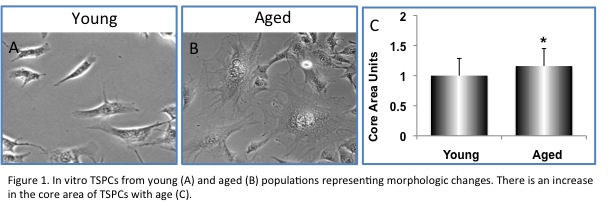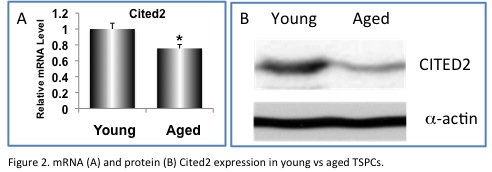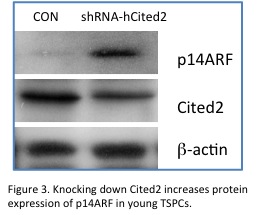|
Back to 2011 Program
The role of Cited2 in inhibiting the age-related increase in senescence of tendon-derived stem progenitor cells
Takintope Akinbiyi, MD, Donna Eckstein, BA, Lili Xu, PhD, Peter J. Taub, MD, Herb B. Sun, PhD.
The Mount Sinai School of Medicine, New York, NY, USA.
BACKGROUND:The inherent deficits in tendon healing seen in aged populations can adversely affect the outcome of the surgical repair of tendons. Previous studies suggest that this age-related decline in healing may be due to a reduction in the number and activity of tendon-derived stem progenitor cells (TSPCs). These cells reside in the tendon matrix and are responsible for maintaining tenocyte populations. The mechanism leading to this decrease is unknown. The transcription factor CITED2 (CBP/p300-Interacting-Transactivator-with-ED-rich-tail-2) is a potent suppressor of cell senescence, in which p14ARF plays a critical role. We recently found that CITED2 is strongly expressed in young TSPCs, but its levels decline with age. In this study, we hypothesized that the age-related decline in CITED2 levels allow for an increase in TSPC senescence resulting in decreased tendon healing with age from increased p14ARF expression.
METHODS:Human biceps brachii tendons (Young: less than age 40; Aged: greater than age 60) were collected as surgical discards and TSPCs were isolated and cultured.
CITED2 knockdown. P0 TSPCs were transfected with CITED2 shRNA, or scramble shRNA (control) using Oligofectamin (Invitrogen) per the manufacturer's protocol. GFP (+) cells were sorted by flow cytometry.
RT-PCR. Total RNA was isolated (Qiagen RNeasy Minikit) and a two-step RT-PCR was performed.
Western Blot. Protein extracts were separated by SDS-PAGE, blotted onto nitrocellulose membranes, probed with specific antibodies and detected by chemiluminescence.
RESULTS:Morphology. With age, TSPCs adopted a more flattened morphology (Fig 1 A,B,C) with increased relative surface area (young 1.0±0.29, aged 1.16±0.29;p<0.05), characteristic of senescent cells.
Cited2 expression. With age, both mRNA (Fig 2A) (young 1.0±0.073, aged 0.76±0.049;p<0.05), and protein expression of Cited2 (Fig 2B), a factor known to maintain cell morphology and proliferation, were reduced.
Cited2 protects against senescence. When Cited2 expression was knocked down in young TSPCs, expression of the senescence factor p14ARF increased to levels observed in TSPCs from aged individuals (Fig 3).
CONCLUSIONS:Taken together, these results strongly suggest that Cited2 suppresses senescence in human TSPCs and its age-related decline may be responsible for impaired tendon healing observed in aged populations.   
Back to 2011 Program
|










